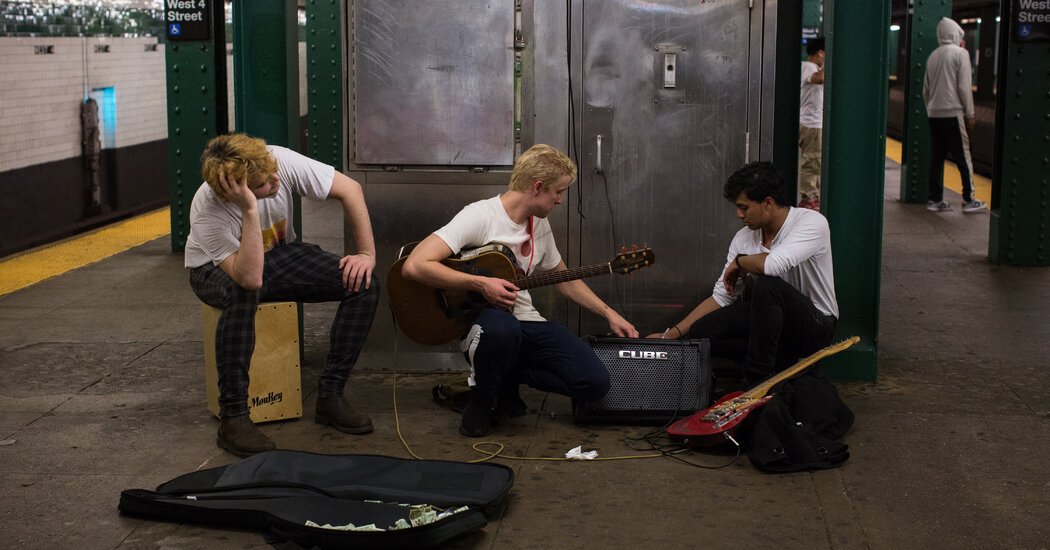‘It Felt So New York’: One Year on the Subway – The New York Times
The city has begun to recover from the pandemic in fits and starts. Throughout, the world underneath the streets has mirrored the suffering, and joys, of the city above.
Credit…
Supported by
Photographs and Text by Ali Kate Cherkis
On an eerily warm Thursday evening in mid-October, I was walking up and down the platform at the 8th Avenue L station when a masked bridal party floated down the stairs and boarded the next-departing train.
The bride, wearing a satin gown and glittering sneakers, held a bouquet of pink- and- peach-colored roses. She beamed as she sat down and nuzzled her head onto the groom’s shoulder. The other passengers in the car seemed unfazed, checking their phones, waiting for the L to start heading east again.
In a year of such immense loss, I felt a small comfort in knowing that we could still witness our neighbors in moments of joy, having their own masked milestones.
It felt so New York to share this underground space again.
In January, I set out to document the subway as the city came out of one of the worst moments of the pandemic. As spring trickled by and vaccinations increased, I saw fewer masks and latex gloves. Summer brought a brief respite: Tourists were returning to find dollar slices and take High Line selfies, and Showtime was back.
But the city’s recovery has come in fits and starts. First, Delta arrived, and now Omicron. Subway ridership is still just slightly more than half of what it was prepandemic. We don’t know if it will ever return to the way it was.
Yet still, the city underground mirrors the city above, ridership revealing a widening disparity between those who have been fortunate enough to adapt and move forward, and those who have been left behind.
In early November, I saw a man overdose on the J train at Broad Street. The needle rolled back and forth across the speckled gray floor as he sat slumped over, unresponsive. It wasn’t the first needle I’ve seen, and as the opioid epidemic worsens, it won’t be the last. And as the cold sets in, and the eviction moratorium expires, we will see more people seeking shelter underground.
But I’ve also been heartened by my fellow New Yorkers: High school graduates in their caps and tassels quietly celebrating with their families even as their ceremonies get canceled. New parents tending to their babies. Quarantine lovers embracing next to tired nurses cracking jokes.
I once saw a platinum-haired drag queen wearing a python-printed bodysuit at Union Square Station. She is immunocompromised, and had only recently started performing again once she was fully vaccinated and the city’s vaccination mandate was in place.
I’ve seen B&H Photo hats, Bernie Sanders hats and Black Rifle Coffee Company hats. I’ve seen many masked riders, and many barefaced police officers.
One time, on the S platform at Grand Central, Curtis Sliwa sprinted past me wearing a crimson mask that matched his beret. He shouted “Hello!” and waved to the train operator whom I was taking a portrait of.
The one constant? Metropolitan Transportation Authority workers. I’ve spoken to dozens of them and their kindness and patience continue to astound me.
Tyrone Bryant, a station agent at Carroll Street, has been working for the M.T.A. for 24 years. Mr. Bryant, 55, lost his 28-year-old son Tyrell to Covid in April 2020. He found support from his family, friends and the Carroll Gardens community who gave him “a lot of encouragement to stay strong,” he said.
Mr. Bryant is a steady presence in the neighborhood, always waving hello and helping people out. “That makes me feel good,” he said. “It lets me know that I’m doing my job. That I have a positive effect on people. I always try to help the customer the same way I would want them to help me if I were on the other side of the glass.”
Regardless of what the pandemic brings, this year underground has shown me that New Yorkers will move forward, carrying with us those we’ve lost as we search for a new understanding of each other in this shared space.
The Year in Photos: Look through the pictures that helped us tell the story of 2021.
2021 Firsts: A round-up of events and trends, surprising and serious, noted for the first time ever this year.
Making Black History: Here are the achievements that shaped the first year following the country’s racial reckoning.
Moments in Sport: In 2021, players and leagues tried to return to normal in the shadow of the coronavirus.
Quiz: Do you recognize the notable people whose stories defined the year?
Advertisement




